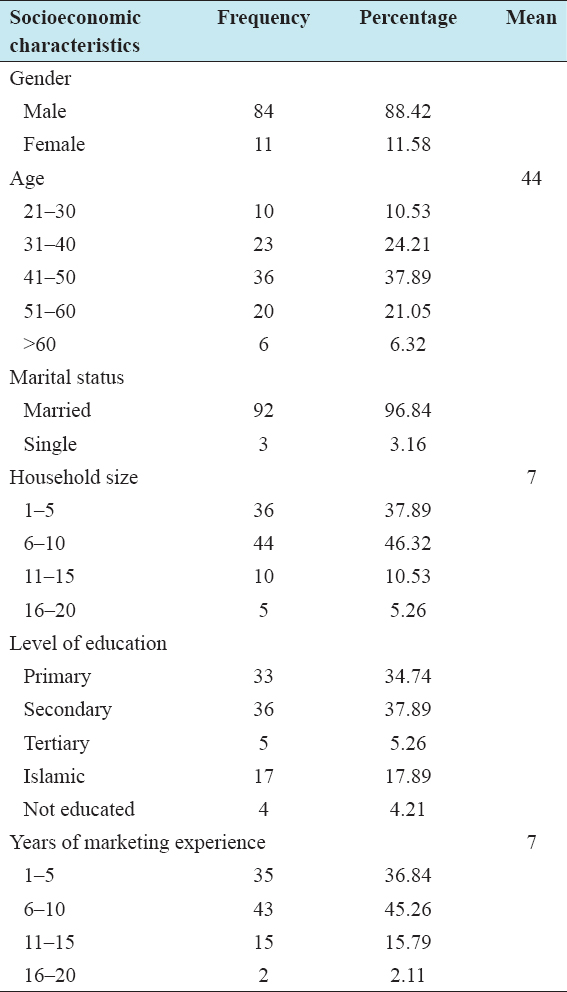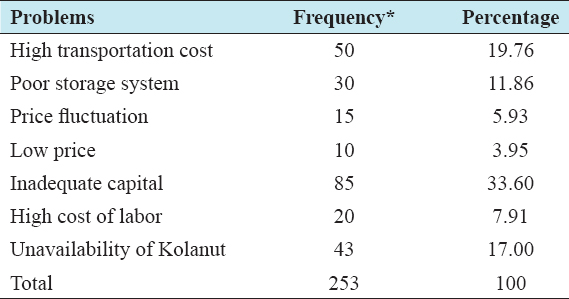1. Ojo SO, Ehinmowo OO. Economic analysis of kola-nut production in Nigeria. J Soc Sci 2010;22:1-5.
2. Oluyole KA, Akinpelu AO, Yahaya AT. Economic Analysis of Kolanut Marketing in Osun and Ogun States of Nigeria. Proceedings of the 54th Annual Conference of Agricultural Society of Nigeria 2021. Nigeria:AE-FUNAI;2021. 1218-23.
3. Eijnatten CL. Kola:A review of the literature. Trop Abstr 1973;28:1-10.
4. Oludemokun AA. Processing, storage and utilization of kolanuts, Cola nitida and Cola acuminata. Trop Sci 1983;24:111-7.
5. Opeke LK. Tropical Tree Crops. Ilorin:Woye and Sons Ltd.;1987. 327.
6. Brickell C, Cole T, Marc-Cathey H. The American Horticultural Society Encyclopedia of Plants and Flowers. New York:D.K. Publishing;2002. 720.
7. Tachia-Obeng, Brown 2004. Available from:http://www.carpe.umd.edu/documents2001/report-tachiaobengbrown2001/pdf?.
8. Catherine M. Kolanut production processing and utilization. Afr Sci 2011;2011:70.
9. Asogwa EU, Anikwe JC, Mokunye FC. Kola production and utilization for economic development. Afr Sci 2006;7:217-22.
10. Opeke LK. Tropical Commodity Tree Crops. Ibadan, Nigeria:Spectrum Books Limited;2005.
11. Asogwa EU, Otuonye AH, Mokwunye FC, Oluyole KA, Ndubuaku TC, Uwagboe EO. Kolanut production, processing and marketing in the South-Eastern states of Nigeria. Afr J Plant Sci 2011;5:547-55.
12. Anozie RO, Okelola OE, Ivoke GE. Economic analysis of banana fruits marketing in Ivo local government area of Ebonyi state, Nigeria. In:Sustainable Strategies for Enhancing Food Security and Livelihoods in Nigeria. 52nd Annual Conference of Agricultural Society of Nigeria. Abuja:ARCN;2018. 179-84.
13. Lawrence OO, Adebiyi GD. Determinants of market participation by maize farmers in Ondo state, Nigeria. J Econ Dev 2014;5:69-77.
14. Ariyo OC. Determinants of fuel wood marketing in Igabi local government area of Kaduna state, Nigeria. J Forest Res Manage 2019;16:148-59.
15. Ariyo OC, Alabi OF, Ariyo MO, Idowu SD, Okelola OE. Determinants of Bushmeat marketing in Kaduna metropolis of Kaduna State, Nigeria. In:Anamayi SE, Balogun SO, Henry S, Olagunju OE, Olusegun OA, Mudashiru MA, et al., editors. Diversification of the Nigerian Economy Where Lies Agriculture. Proceedings 19th Annual Conference of the Nigerian Association of Agricultural Economists (NAAE) held at Federal College of Forestry Mechanization (FCFM). Afaka, Kaduna:Nigerian Association of Agricultural Economists;2018. 1097-103.
16. Oluwalana EO, Okojie LO, Ashaolu FO, Olaniran VO. An analysis of yields of kola-nut production, processing and marketing in Sagamu Lga, Ogun state, Nigeria. J Hum Soc Sci Creative Arts 2016;11:88-103.
17. Taiwo O, Shitu TR, Lawal JO, Yahaya AT, Okeowo TA. Analysis of factors affecting the marketing of kola nut in Ogun state, Nigeria. Asian J Agric Extens Econ Sociol 2017;19:1-6.
18. Carr M, Chen M, Tate J. Globalization and home-based workers. Feminist Econ 2000;6:123-42.
19. Adebayo S, Oladele O. Medicinal values of kolanut in Nigeria:Implication for extension service delivery. Life Sci J 2012;9:887-91.
20. Momoh S, Dipeolu AO, Oluwalana SA. Economics of kolanut production in Ogun State, African scientist. Asian J Agric Exten Econ Sociol 2000;1:33-40.
21. Food and Agriculture Organisation. The Major Significance of Minor Forest Products:Special Report, Forestry Department. Rome, Italy:Food and Agriculture Organisation;2005. Available from:http://www.fao.org.
22. Eusebus JM. Improving small holder marketing in Africa:The case of maize Sustainable Agriculture Center for Research Extension and Development in Africa, Kenya. Berlin, Germany:Springer;2004. 63-8.
23. Taiwo O, Mokwunye IU, Mokwunye FC, Adebowale LA. Analysis of the impact of Pest infestation and its correlates among kola marketers in Ogun State, Nigeria. Int J Chem Gas Mater Sci 2017;1:27-34.
24. Ajani EN, Onwubuya EA. Marketing infrastructure for kola-nut in Ika local government area of Delta state, Nigeria. J Emerg Trends Comput Inform Sci 2012;3:5.
25. National Commission on Population. National Population Commission, Federal Office of Statistics. Census. Nigeria:National Commission on Population;2006.
26. National Medical Association. Nigerian Meteorological Agency, North Central, Kaduna, Kaduna State. African:National Medical Association;2012.
27. Gupta SP. Statistical Methods. 31th ed. New Delhi:Gultan Chand and Sons Educational;2002:75-6.
28. Olagunju OE, Ariyo OC, Emeghara UU, Olagunju OS, Olafemi SO. Determinants of farmer's attitude to plant agro-forestry trees in Kaduna state, Nigeria. J Adv Res 2020;21:155-66.
29. Adewumi OR. Marketing of Kola Nut in Moba Local Government of Ekiti State, Nigeria. Agric Economics and Farm Management. Abeokuta:Federal University of Agriculture;2003.
30. Agwu AE, Anyaeche CL. Adoption of improved cassava varieties in six rural communities of Anambra state, Nigeria. Acad J 2007;6:89-98.
31. Nwawuisi JU, Okoye BC, Odaji CO. Adoption of Improved Cassava Varieties (TMS 30211 and TMS 3001) in Ivo L.G.A of Ebonyi State. Samaru:Paper Presented at the Proceedings of the 41st Conference of the Agricultural Society of Nigeria;2007. 527-30.
32. Nwaru JC. Rural Credit Markets and Arable Crop Production in Imo State of Nigeria. Unpublished Ph.D. Dissertation Umudike:Nigeria Michael Okpara University of Agriculture;2004.
33. Banabana-Wabbi J. Assessing Factors Affecting Adoption of Agricultural Technologies:The Case of Integrated Pest Management (IPM) in Kumi District, Eastern Uganda. Unpublished M.Sc Thesis. Virginia:Department of Agricultural and Applied Economics, Virginia Polythenic Institute and State University USA;2002.
34. Albert CO, Ladu T, Isife BI. Assessment of women involvement in cassava processing in Ikwerre local government area of rivers state, Nigeria. Int J Appl Res Technol 2017;6:44-51.
35. Nwaru JC, Nwosu AC, Agommuo VC. Socioeconomic determinant of profit in wholesale and retail banana marketing in Umuahia agricultural zone of Abia state, Nigeria. J Sustain Dev Afr 2011;13:200-9.
36. Esiobu NS, Nwosu CS, Onubuogu GC. Economics of pineapple marketing in Owerri Municiupal Council Area, Imo state, Nigeria. Int J Appl Res Technol 2014;3:3-12.
37. Okoye BC, Onyenweaku CE, Ukoha OO. Effect of Transaction Costs on Seller Decisions Among Small-holder Cassava Production in South-Eastern, Nigeria:Paper Presented at the 11th Annual National Conference of Natural Association of Agricultural Economist Held at Federal University of Technology (FUT). Minna, Nigeria:University of Technology;2010. 183-7.
38. Offor EI, Nse-Nelson FA, Asokome F. Determinants of marketing efficiency of yam market in Umuahia North local government area of Abia state, Nigeria. Agro Sci J Trop Agric Food Environ Exten 2016;15:54-8.
39. Laper ML, Holloway G, Ehui G. Polari options promoting market participation among smallholder livestock producers:A case study from Philippines. Food Policy 2003;28:189-211.
40. Ndaghu AA, Taru VB, Tizhe I, Tizhe J. Analysis of socio economic characteristics of fuel wood marketers in yola metropolis, Adamawa state, Nigeria. J Hum Ecol 2011;36:153-7.
41. Okoye BC. Analysis of market participation among small-holder cassava famers in response to transaction cost in South Eastern Nigeria. Ph.D. Dissertation. Umudike, Abia, Nigeria:Michael Okpara University of Agriculture;2011. 145.
42. Adedokun MO, Soaga JA, Olawumi AT, Oyebanji OO, Oluwalana SA, Imaledo EA. Socio-economic contribution, marketing and utilization of edible kolanut (Cola acuminata and Cola nitida) to rural women livelihood in Abeokuta, Nigeria. Int J Mol Ecol Conserv 2012;2:32-8.
43. Ashaye WO, Daramola RB, Anyaeji FO, Wahab AA, Alao B. Marketing of Kolanut (Cola nitida) in Sagamu and Ikenne local government areas of Ogun state. Continental J Soc Sci 2017;10:1-11.
44. Osalusi CS. Price determinant of kolanut in selected markets in Ibadan, Oyo state, Nigeria. Int J Forest Anim Fisher Res 2019;3:109-12.



